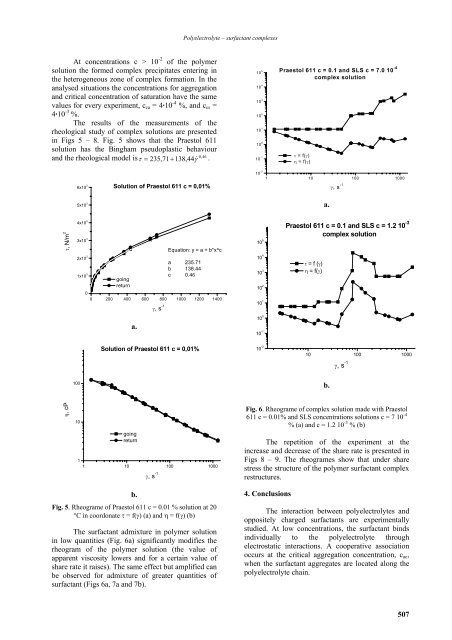2007_6_Nr6_EEMJ
You also want an ePaper? Increase the reach of your titles
YUMPU automatically turns print PDFs into web optimized ePapers that Google loves.
Polyelectrolyte – surfactant complexes<br />
At concentrations c > 10 -2 of the polymer<br />
solution the formed complex precipitates entering in<br />
the heterogeneous zone of complex formation. In the<br />
analysed situations the concentrations for aggregation<br />
and critical concentration of saturation have the same<br />
values for every experiment, c ca = 4·10 -4 %, and c cs =<br />
4·10 -3 %.<br />
The results of the measurements of the<br />
rheological study of complex solutions are presented<br />
in Figs 5 – 8. Fig. 5 shows that the Praestol 611<br />
solution has the Bingham pseudoplastic behaviour<br />
0, 46<br />
and the rheological model isτ<br />
= 235,71+<br />
138,44 & γ .<br />
10 4<br />
10 3<br />
10 2<br />
10 1<br />
10 0<br />
10 -1<br />
Praestol 611 c = 0.1 and SLS c = 7.0 10 -4<br />
complex solution<br />
τ = f(γ)<br />
η = f(γ)<br />
10 5 γ, s -1<br />
6x10 3<br />
Solution of Praestol 611 c = 0,01%<br />
10 -2<br />
1 10 100 1000<br />
5x10 3<br />
a.<br />
τ, N/m 2<br />
4x10 3<br />
3x10 3<br />
2x10 3<br />
1x10 3<br />
going<br />
return<br />
Equation: y = a + b*x^c<br />
a 235.71<br />
b 138.44<br />
c 0.46<br />
0<br />
0 200 400 600 800 1000 1200 1400<br />
a.<br />
γ, s -1<br />
Praestol 611 c = 0.1 and SLS c = 1.2 10 -3<br />
complex solution<br />
10 5<br />
10 4<br />
10 3<br />
10 2<br />
10 1<br />
10 0<br />
10 -1<br />
τ = f (γ)<br />
η = f(γ)<br />
Solution of Praestol 611 c = 0,01%<br />
10 -2<br />
10 100 1000<br />
γ, s -1<br />
100<br />
b.<br />
η, cP<br />
10<br />
going<br />
return<br />
1<br />
1 10 100 1000<br />
γ, s -1<br />
Fig. 6. Rheograme of complex solution made with Praestol<br />
611 c = 0.01% and SLS concentrations solutions c = 7 10 -4<br />
% (a) and c = 1.2 10 -3 % (b)<br />
The repetition of the experiment at the<br />
increase and decrease of the share rate is presented in<br />
Figs 8 – 9. The rheogrames show that under share<br />
stress the structure of the polymer surfactant complex<br />
restructures.<br />
b.<br />
Fig. 5. Rheograme of Praestol 611 c = 0.01 % solution at 20<br />
°C in coordonate τ = f(γ) (a) and η = f(γ) (b)<br />
The surfactant admixture in polymer solution<br />
in low quantities (Fig. 6a) significantly modifies the<br />
rheogram of the polymer solution (the value of<br />
apparent viscosity lowers and for a certain value of<br />
share rate it raises). The same effect but amplified can<br />
be observed for admixture of greater quantities of<br />
surfactant (Figs 6a, 7a and 7b).<br />
4. Conclusions<br />
The interaction between polyelectrolytes and<br />
oppositely charged surfactants are experimentally<br />
studied. At low concentrations, the surfactant binds<br />
individually to the polyelectrolyte through<br />
electrostatic interactions. A cooperative association<br />
occurs at the critical aggregation concentration, c ac ,<br />
when the surfactant aggregates are located along the<br />
polyelectrolyte chain.<br />
507


